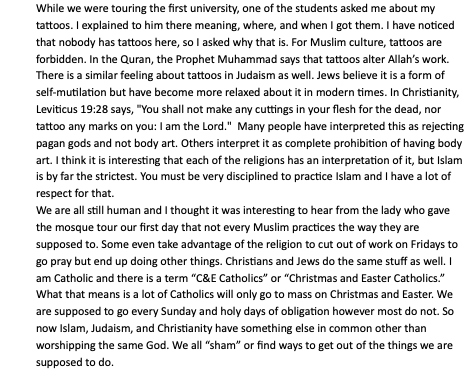Navigating social status, land access and the culture of the Berbers
Something we didn’t spend a lot of time discussing but I wished to pull in more information on is the social status of the indigenous people of Morocco. We heard bits and pieces about the Berber culture but never from the Berber people themselves and the context of our exposure was often the commodification of their traditions. The beautiful heritage displayed in the art pieces, rugs, garments, and music tell a story of people and the Atlas Mountains. A way of life that has been torn away piece by piece in the pursuit of a modern profitable Morocco. As we heard at Zineb’s extension learning farm for Berber women, their people have been pushed to abandon their nomadic pastoralist way of life for a sedentary farming life at a time where the conditions are unprecedented in climate and water accessibility.
According to the article I pulled for this blog post, the tension between the ethnic groups in Morocco still very much exists. The Berbers claim uncleared lands in the Middle Atlas as ancestral land but this is challenged by outsiders who settle and claim these lands as their own for farming. (Venema, B., & Ali Mguild. 2003) This connects back to the program at Terre de Humanisme, where Berber women are being taught how to cultivate the land in a sedentary orientation which allows them to maintain their claims on the land but for a "more productive" use. The divisions between the Arabic and Berber-speaking populations were explicitly defined by law in the colonial era but later the groups were granted equal access to opportunities by the government. But within the Berber society, only descendants of the people who initially helped conquer the area are community members entitled to the privileges of their lineage. Lineage heritage was historically denied to outsiders meaning they were not allowed to obtain land and they had no right to the collective pastures or water resources. So while the Berber people occupy the minority in Morocco as a whole, within their own culture, outsiders are viewed as inferior. The leadership structure in Berber communities is essential to how they operate and social identity conflicts are very common. Faultlines are visible as more and more non-indigenous people enter the Berber domain and aim to acquire Berber land. These entrances into the community are triggers that put the Berber people on edge and the protocol is differential treatment for outsiders. Lineage councils have been defensive of the Moroccan government's policy of free settlement and have deemed newcomers intruders unless they perform a cultural custom tamaghrouste ceremony and serve the community as a whole. Formal assimilation and appreciation for Berber culture and customs is necessary to be granted access to the community. The only exposure I was given to Berber people and agriculture was the majorities attempts to force assimilation into the majority culture, so it is very interesting to learn about the ways the Berbers have incorporated resistance to outsiders into their community.
When I set out to write this article, I had oriented myself to understand the Berber people and culture through the lens of the Arab Moroccan majority but after stumbling across this article I realized how fascinating it was that I had been inclined to understand the Berber's from the majority perspective ahead of the Berber perspective. It was helpful in seeing that it is also the minority culture that can emphasis the us versus them divisions as a way to safeguard their own culture and traditions.
References:
Venema, B., & Ali Mguild. (2003). Access to Land and Berber Ethnicity in the Middle Atlas, Morocco. Middle Eastern Studies, 39(4), 35–53. http://www.jstor.org/stable/4284326



Katie, I am so glad you wrote about this! One thing that fascinates me the most, even in our own country, is the indigenous populations and their way of life. I was not at all surprised to find out the rug, which really spoke to me, was a Berber design and Berber made. Nor was I surprised to find I strongly preferred the folk music over the other types. While it is hard for me to imagine a nomadic way of life, I was thrilled to see so many flocks with their nomadic shepherds when we traveled through the mountains. While assimilation may be forthcoming as Morocco strives to become modernized, it is refreshing to know there are still bands on indigenous peoples holding on to their way of life. We lost too much of that with our own Native populations. However, I am in hopes that the proven archaic ways of life will not be completely forgotten as the country advances. Certainly, their expertise in survival of such arid conditions over thousands of years holds valuable wisdom, resources and knowledge. I would love to spend more time learning about and discuss indigenous knowledge systems. My prayer is Morocco will find a perfect balance between the traditional Berber way of life and a 21st century lifestyle.
ReplyDelete